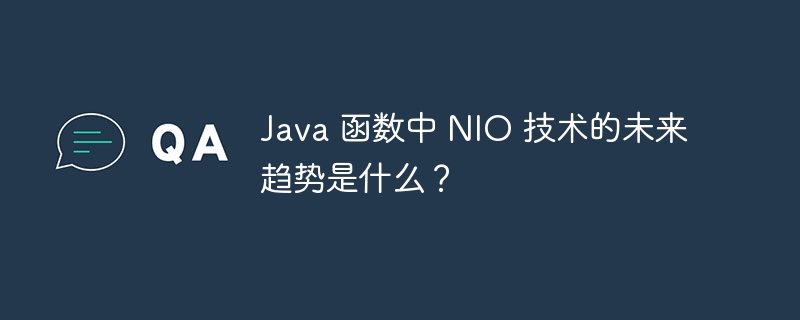What are the future trends of NIO technology in Java functions?

The future trend of NIO technology in Java functions
Java functions using non-blocking IO (NIO) technology are becoming a trend in cloud computing and micro An increasingly popular trend in service architecture. NIO technology enables high-concurrency, low-latency applications by allowing programs to read and write data from the network without blocking.
Advantages of NIO technology
- High concurrency: NIO allows programs to handle multiple connections at the same time without having to wait for a single connection to come up blocking I/O operations, thereby improving concurrency.
- Low latency: NIO avoids blocking calls, thereby eliminating common latency issues with synchronous I/O.
- Efficient resource utilization: NIO uses fewer threads and fully utilizes server resources.
Future Trend of NIO Technology in Java Functions
- Serverless Computing: NIO Technology’s Lightweight and The efficiency makes it an ideal choice for serverless architecture, allowing cloud service providers to provision resources on demand.
- Event-driven programming: NIO is highly compatible with the event-driven programming model, allowing functions to process information only when there are new events (such as an incoming connection or data being readable).
- Asynchronous programming: Asynchronous NIO libraries (such as NIO.2) allow functions to initiate I/O operations while processing other tasks, further improving concurrency and responsiveness.
Practical case: Using NIO to create Java functions
import java.io.IOException;
import java.net.InetSocketAddress;
import java.nio.ByteBuffer;
import java.nio.channels.AsynchronousServerSocketChannel;
import java.nio.channels.AsynchronousSocketChannel;
import java.nio.channels.CompletionHandler;
public class NioFunction {
// 服务端函数
public static void main(String[] args) throws IOException {
AsynchronousServerSocketChannel server = AsynchronousServerSocketChannel.open();
server.bind(new InetSocketAddress(8080));
// 接受客户端连接
server.accept(null, new CompletionHandler<>() {
@Override
public void completed(AsynchronousSocketChannel client, Object attachment) {
server.accept(null, this);
ByteBuffer buffer = ByteBuffer.allocate(1024);
client.read(buffer, null, new CompletionHandler<>() {
@Override
public void completed(Integer result, ByteBuffer attachment) {
// 处理接收到的数据
...
// 将数据写回客户端
buffer.flip();
client.write(buffer);
}
@Override
public void failed(Throwable exc, ByteBuffer attachment) {
...
}
});
}
@Override
public void failed(Throwable exc, Object attachment) {
...
}
});
}
}The above is the detailed content of What are the future trends of NIO technology in Java functions?. For more information, please follow other related articles on the PHP Chinese website!

Hot AI Tools

Undresser.AI Undress
AI-powered app for creating realistic nude photos

AI Clothes Remover
Online AI tool for removing clothes from photos.

Undress AI Tool
Undress images for free

Clothoff.io
AI clothes remover

AI Hentai Generator
Generate AI Hentai for free.

Hot Article

Hot Tools

Notepad++7.3.1
Easy-to-use and free code editor

SublimeText3 Chinese version
Chinese version, very easy to use

Zend Studio 13.0.1
Powerful PHP integrated development environment

Dreamweaver CS6
Visual web development tools

SublimeText3 Mac version
God-level code editing software (SublimeText3)

Hot Topics
 1377
1377
 52
52
 Perfect Number in Java
Aug 30, 2024 pm 04:28 PM
Perfect Number in Java
Aug 30, 2024 pm 04:28 PM
Guide to Perfect Number in Java. Here we discuss the Definition, How to check Perfect number in Java?, examples with code implementation.
 Random Number Generator in Java
Aug 30, 2024 pm 04:27 PM
Random Number Generator in Java
Aug 30, 2024 pm 04:27 PM
Guide to Random Number Generator in Java. Here we discuss Functions in Java with examples and two different Generators with ther examples.
 Weka in Java
Aug 30, 2024 pm 04:28 PM
Weka in Java
Aug 30, 2024 pm 04:28 PM
Guide to Weka in Java. Here we discuss the Introduction, how to use weka java, the type of platform, and advantages with examples.
 Smith Number in Java
Aug 30, 2024 pm 04:28 PM
Smith Number in Java
Aug 30, 2024 pm 04:28 PM
Guide to Smith Number in Java. Here we discuss the Definition, How to check smith number in Java? example with code implementation.
 Java Spring Interview Questions
Aug 30, 2024 pm 04:29 PM
Java Spring Interview Questions
Aug 30, 2024 pm 04:29 PM
In this article, we have kept the most asked Java Spring Interview Questions with their detailed answers. So that you can crack the interview.
 Break or return from Java 8 stream forEach?
Feb 07, 2025 pm 12:09 PM
Break or return from Java 8 stream forEach?
Feb 07, 2025 pm 12:09 PM
Java 8 introduces the Stream API, providing a powerful and expressive way to process data collections. However, a common question when using Stream is: How to break or return from a forEach operation? Traditional loops allow for early interruption or return, but Stream's forEach method does not directly support this method. This article will explain the reasons and explore alternative methods for implementing premature termination in Stream processing systems. Further reading: Java Stream API improvements Understand Stream forEach The forEach method is a terminal operation that performs one operation on each element in the Stream. Its design intention is
 TimeStamp to Date in Java
Aug 30, 2024 pm 04:28 PM
TimeStamp to Date in Java
Aug 30, 2024 pm 04:28 PM
Guide to TimeStamp to Date in Java. Here we also discuss the introduction and how to convert timestamp to date in java along with examples.
 Create the Future: Java Programming for Absolute Beginners
Oct 13, 2024 pm 01:32 PM
Create the Future: Java Programming for Absolute Beginners
Oct 13, 2024 pm 01:32 PM
Java is a popular programming language that can be learned by both beginners and experienced developers. This tutorial starts with basic concepts and progresses through advanced topics. After installing the Java Development Kit, you can practice programming by creating a simple "Hello, World!" program. After you understand the code, use the command prompt to compile and run the program, and "Hello, World!" will be output on the console. Learning Java starts your programming journey, and as your mastery deepens, you can create more complex applications.




